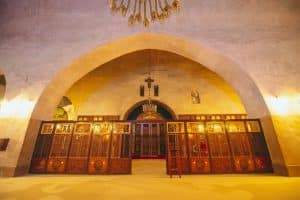 After passing through the stairwell dominated by the early medieval arch, on the left is the Church of Saint Macarius the Great which. This church comprises two transverse choirs running north to south with three sanctuaries and a middle oblong cell. This building is only a part of the historical church which in some historical epochs arrived to cover the whole esplanade which nowadays develops around the church. Already in the twelfth to fourteenth centuries, visitors had no doubt that the church now existing is a mere relic—though an important relic—of a once great whole. From these late medieval writings, we know that there were four main sanctuaries with a cell of the maglis, or Council, in their midst, and that to the west of the choir was a nave divided by arcades into four riwāq, or alleys. There were two subsidiary sanctuaries or side chapels that were dedicated to St Macarius (next to Pope Benjamin’s sanctuary) and St Shenuda.[1] According to Evelyn-White account during his staying in 1920 with the monks of the monastery, the church in its maximum extension came to contain seven sanctuaries.[2]
After passing through the stairwell dominated by the early medieval arch, on the left is the Church of Saint Macarius the Great which. This church comprises two transverse choirs running north to south with three sanctuaries and a middle oblong cell. This building is only a part of the historical church which in some historical epochs arrived to cover the whole esplanade which nowadays develops around the church. Already in the twelfth to fourteenth centuries, visitors had no doubt that the church now existing is a mere relic—though an important relic—of a once great whole. From these late medieval writings, we know that there were four main sanctuaries with a cell of the maglis, or Council, in their midst, and that to the west of the choir was a nave divided by arcades into four riwāq, or alleys. There were two subsidiary sanctuaries or side chapels that were dedicated to St Macarius (next to Pope Benjamin’s sanctuary) and St Shenuda.[1] According to Evelyn-White account during his staying in 1920 with the monks of the monastery, the church in its maximum extension came to contain seven sanctuaries.[2]
Of the three existing sanctuaries, the central and northern are the medieval sanctuaries of Pope Benjamin and Saint John the Baptist (previously known as St Mark because it contained St Mark’s head), respectively. On the southern part of the church is the sanctuary of the Three Young Men of Babylon divided from Pope Benjamin’s sanctuary by the cell of the Council.
The nave
The width of the nave must have been equal to the total width of the four sanctuaries together with the cell of the Council, since each of the four riwāq (naves) into which it was divided corresponded to one of the latter. Consequently, the south wall of the whole nave must have stood on the site which was occupied by the range of cells (built 1910—1911 and partly pulled down at the beginning of the 1970s) to the south of the court. Of this wall the existing north wall of the Church of Abba Ischyron was surely part of the original church. As we know, the vaulted portion of its choir and nave formed the porch of the Great Church.
The northern wall of the nave which belongs to Saint John the Baptist stroke almost immediately into the range of cells bounding the court upon its northern side. These cells were relatively late, built, perhaps, in the seventeenth century, yet no longer exist.
There are two facts that provide an approximate length for the nave. Sicard (1712) tells us that he saw in the church twenty marble columns. These certainly stood in the nave, in the colonnaded alleys mentioned in the Book of the Chrism. The length of the nave in the 18th century, then, had to be not less than 15 meters. Thus, the nave extended westward almost as far as the small Church of the forty-nine Elders, which may indeed have been connected with it by some means. Between the 18th and the 20th century, the nave was sensibly reduced because the second choir almost certainly collapsed. At the time of Evelyn-White, there was one only choir which roughly corresponds to the present eastern choir (where morning praises are prayed). During the refoundation of 1969, Father Matthew the Poor partly reconstructed the nave that went lost between the 18th and the 20th century. Thus, now we have two choirs divided by three arches.
Pope Benjamin’s Sanctuary
The current sanctuary of Pope Benjamin is very different from its original. Pope Benjamin said about this sanctuary: “It was as if I had entered Heaven, the congregation of angels, the joy of the saints, the resting place of the righteous.”[3]
Evelyn-White confirms Pope Benjamin’s statement by saying that “the whole interior was aglow with color when through the richly tinted panes of the windows a flood of warm light was shed upon paintings representing the inhabitants of heaven itself, so that many a pious mystic may have almost persuaded himself that he had already reached the celestial courts.”[4]
The present sanctuary was built in the 7th century by Pope Benjamin I, consecrated in 655 AD, and restored by Abba James after the raid of 817, probably between 825 and 830 AD. In the eleventh century we hear of a new sanctuary (that of St Macarius) being built on the south side of the principal church. The existing north sanctuary was most probably added at the same period (St Mark and John the Baptist’s sanctuary), but is markedly later in style than the main sanctuary. Thus, no other than an early ninth-century date for the sanctuary seems possible, that is that the sanctuary we see today is the one built by Pope Benjamin as it was restored by Abba James about 830 AD. Moreover, it must be recognized that in this building we find the earliest dated monument in Egypt in which the pointed arch occurs. The stucco window traceries are unique examples in Egypt.
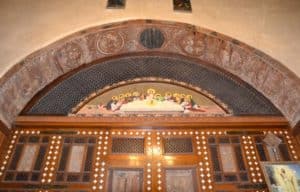 The Wooden Arch
The Wooden Arch
The medallion or arch paintings above the sanctuary’s door deserve attention. They are nine, one at the apex of the arch and four on either side. Each medallion, separated from the next by a rather florid plant of six sprays springing from a small cup, is surrounded by a circular white border. The background is a dull, rather deep yellow with white used for the flesh parts of the figures and for the outer garments, and violet-blue shaded with white for the undergarments. The names of the personages are inscribed in the field in white Coptic lettering. The medallion at the apex has been completely and deliberately effaced and probably contained a golden cross nestled on a black-painted background which has gone lost. The adjoining scene on the north, however, is complete and shows two persons bending over a body lying upon the ground with the face exposed, which they are enwrapping for burial. The subject is determined by the vertical inscriptions which identify the left-hand figure as Nicodemus, the right-hand as Joseph, and the body as that of Christ. It is therefore the embalming of Christ’s body after the Crucifixion by Nicodemus and Joseph of Arimathea which is represented. The corresponding medallion on the south side shows the same two figures, similarly inscribed, carrying the swathed body to the tomb. In the next scene on the south are three figures, of which only the heads are now visible. In the center and on the right, apparently seated, are Christ and Peter; on the left is a woman, or a youth possibly to be identified as Saint John the Evangelist. The last scene distinguishable on the south side, now completely covered, contains two figures. The left is Christ accompanied by a single half-effaced figure which could represent Mary Magdalene.
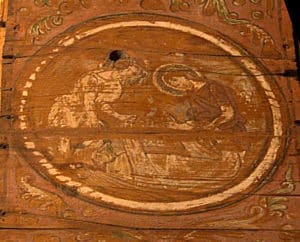
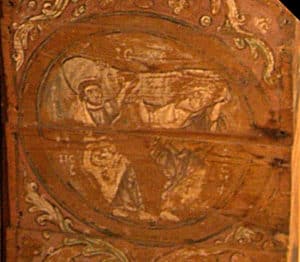 The first and second scenes are of peculiar interest, being evidently selected because of the tradition recorded in the Book of the Chrism that after the Resurrection the disciples took the four hundred raṭls[5] of myrrh and aloes used by Nicodemus and Joseph in the embalmment, and made from them the first myron, with which they anointed the people converted at Pentecost. It must be reminded here that throughout the Middle Ages the myron was consecrated in this sanctuary. Hence, the importance between this location and the making of the Chrism.
The first and second scenes are of peculiar interest, being evidently selected because of the tradition recorded in the Book of the Chrism that after the Resurrection the disciples took the four hundred raṭls[5] of myrrh and aloes used by Nicodemus and Joseph in the embalmment, and made from them the first myron, with which they anointed the people converted at Pentecost. It must be reminded here that throughout the Middle Ages the myron was consecrated in this sanctuary. Hence, the importance between this location and the making of the Chrism.
The third scene seems displaying a woman (the head is covered by a scarf; is she the Virgin Mary?) on the left and another unknown character on the right (is he Nicodemus or Joseph?), both at the tomb.
The date of the paintings is debated. Evelyn-White hypothesizes that they go back to the mid-eleventh century as their style is similar to that of the mural paintings in the north sanctuary. Nevertheless, according to a 2021 field study made by the Egyptian Ministry of the Antiquities, it is possible to bring forward the date up to the 7th century. The reason for that is that on the external part of the arch, thirteen black circles with holes are visible. This suggest that, on each of the circles, a face was mounted to the arch through a support. These thirteen faces could be the twelve apostles with Christ in the middle (a sort of proto-iconostasis) or twelve virtues. A similar construction technique is found at the Bawit monastery where twelve faces, corresponding to twelve virtues, are mounted in a similar way on a wooden arch. Bawit’s work dates back to the 6th century. Only laboratory tests on wood and colors could establish a precise date.
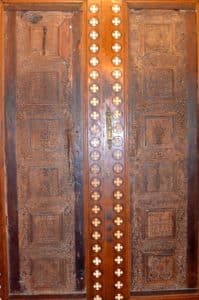 The original screen which protected this sanctuary was doubtless an unusually fine and elaborate piece of work. If it survived the harrying of the monastery by the Lewata Berber tribe in the eleventh century, it was certainly destroyed in the twelfth century by an external criminal monk named Halus (or Halush), who kicked it by his feet and then burnt it at the request of the authorities.[6] It seems to have been replaced after a short interval by a screen in contemporary style (12th century) removed from this church in 1911 for some reasons. Anba Abraam, bishop of al-Balyana, found what remained of the door in a storage room for onions. He resorted it and replaced it back where it was originally. Father Matthew the Poor found other missing pieces (namely some of the cross-decorated fillings) and completed the door. The character of the foliated work suggests a late Fatimid Period or an early date in the Ayyubid Period, which confirms that these doors replaced the screen destroyed by the monk Halus. Along the right edge of the left door is the following lightly cut Coptic inscription:
The original screen which protected this sanctuary was doubtless an unusually fine and elaborate piece of work. If it survived the harrying of the monastery by the Lewata Berber tribe in the eleventh century, it was certainly destroyed in the twelfth century by an external criminal monk named Halus (or Halush), who kicked it by his feet and then burnt it at the request of the authorities.[6] It seems to have been replaced after a short interval by a screen in contemporary style (12th century) removed from this church in 1911 for some reasons. Anba Abraam, bishop of al-Balyana, found what remained of the door in a storage room for onions. He resorted it and replaced it back where it was originally. Father Matthew the Poor found other missing pieces (namely some of the cross-decorated fillings) and completed the door. The character of the foliated work suggests a late Fatimid Period or an early date in the Ayyubid Period, which confirms that these doors replaced the screen destroyed by the monk Halus. Along the right edge of the left door is the following lightly cut Coptic inscription:
Ϧⲉⲛ ⲡⲣⲁⲛ ⲛⲡⲉⲛϭⲥ ⲓⲏⲥ ⲡⲭⲥ ⲡⲉⲛⲛⲟⲩⲧⲓ ⲉⲑⲙⲓ ⲁϣⲱⲡⲓ ⲛϫⲉ ⲡⲁⲓ ⲁⲅⲁⲑⲟⲛ ⲛϣⲉⲛⲉⲣⲫⲛⲉⲃⲓ ⲉⲃⲟⲗϩⲓⲧⲟⲧ ⲫⲏ ⲡⲉⲛⲙⲁⲓⲛⲟⲩϯ ⲁⲃⲣⲁⲁⲙ ⲡϣⲏⲣⲓ ⲛⲁⲓⲁ ⲙⲁ
In the name of our Lord Jesus the Christ, our true God, was made this good memorial through the agency of our God-loving [father] Abraam, the son of Ma…)
Unfortunately, the rest of the inscription, which probably contained the date, has gone lost. But if we consider Abraam to be Abraam of Coltha, abbot in 925 AD, this would confirm that the door was completed during the late Fatimid Period.
The interior
The interior of the sanctuary is a perfect square. Many of the original features—the paintings decorating the walls and the apse—are now only partially visible. In its original condition this sanctuary must indeed have been monumental. The apse is headed with a pointed arch. Here was the seat of the patriarch. It was occupied by a now almost totally erased fresco of the Ascension of our Lord (it was still partially visible at Evelyn-White’s time in 1920). The type represented is an important one. In the center of the composition is a stately, well-proportioned figure with hands upraised as if in prayer. To the right and to the left are four more figures each with a nimbus, making nine in all; four additional figures may have filled the spaces, now coated with modern plaster, adjoining the jambs of the niche. Of these figures three carry books. To the left there should have been the head of a small winged figure, evidently an angel, facing away from the center and supporting what appears to be a frame or border. The figures in the lower part of the niche represent the Virgin surrounded by the apostles gazing upward, while the remainings visible above represent one of the two angels who supported the mandorla in which Our Lord ascended into heaven. The date of this painting is probably to be placed in the eleventh century.
In the north, south, and east walls, each of the eight blank spaces between the upper windows and at the ends of the walls is occupied by a small painting of one of the twenty-four elders of the Apocalypse. Each figure, identified by his name (the termination of one only has survived), is seated in a high-backed, jeweled throne and holds a chalice in his hand. The interesting thing is that each face is painted on a wooden medallion nestled in the wall. On the north and south walls the elders face eastward; on the east wall eight are so arranged as to face toward the center. Each one of the elders was figured with a white crown and a halo. It is remarkable that these priests are here represented as beardless.
The western wall differs in its decoration. Here, in place of the throned elders was a series of large standing figures of which only two have partially escaped the modern layer of plaster. Each figure stands in a painted architectural frame consisting of a pair of columns supporting a rounded arch with a small window in either spandrel. The first, identified by the inscription, [ⲡⲓⲁⲅⲓⲟⲥ] ⲓⲱⲁⲛⲛⲓⲥ | [ⲡⲓⲣ]ⲉϥϯⲱⲙⲥ (“Saint John the Baptist”), written in white upon the black background, has a nimbus, short, broad black beard and hair. He is clad in a dark red tunic, girt by a belt at the waist, and a white-edged mantle of yellow-brown, closed across the breast. With the extended forefinger of his right hand, he points to an oval cartouche in his left containing the Lamb of God in the form of a horned ram, with the inscription ⲡⲓ[ϩⲓ]ⲉⲃ (the Lamb) on the black background. The name of the second figure, of which little remains, is illegible; possibly it was Elias. All these paintings are to be assigned to the ninth century.
When removing the plaster of the western wall of the sanctuary, we found, on the northern side, a drawing representing two martyrs, St. Mina and St. Claudius. Adjacent to them is a beseeching prayer in the Coptic language:
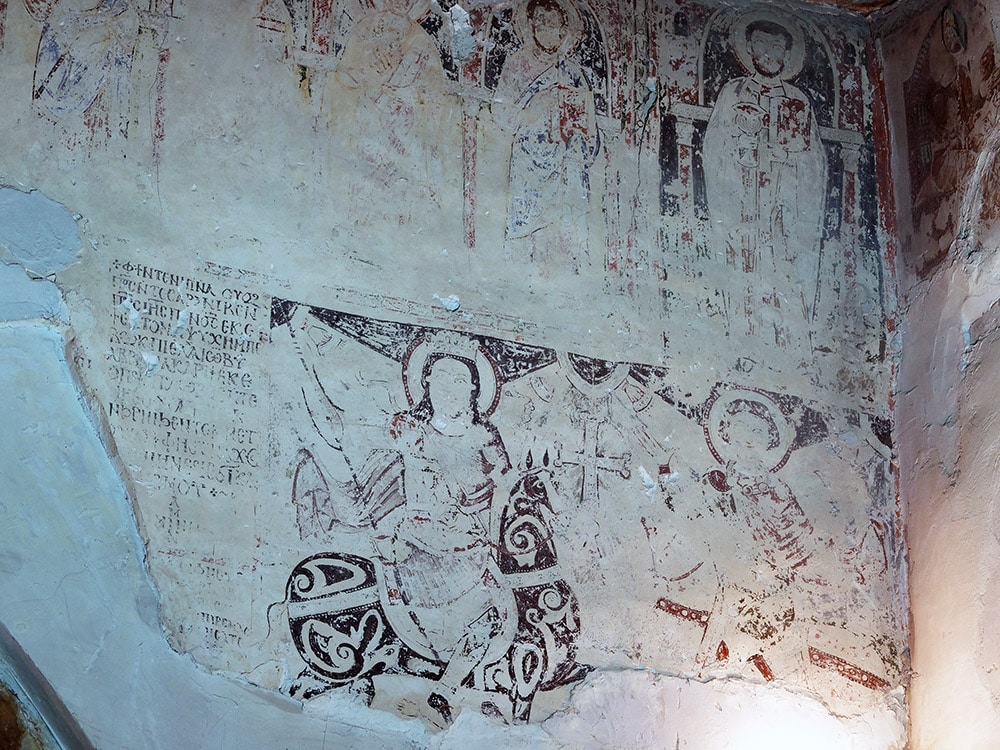
Ⲫϯ ⲛⲧⲉ ⲛⲓⲡⲛⲁ ⲟⲩⲟϩ ⲡϭⲥ ⲛⲧⲉ ⲥⲁⲣⲝ ⲛⲓⲃⲉⲛ ⲡⲭⲥ ⲓⲏⲥ ⲡⲛϭⲥ ⲉⲕⲉϯ ⲉⲙⲧⲟⲛ ⲛⲧⲯⲏⲭⲏ ⲙⲡⲉⲕⲃⲱⲕ ⲡⲓⲉⲗⲁⲭ ⲓⲱⲃ ⲩⲟ ⲁⲃⲃⲁ ⲙⲁⲕⲁⲣⲓ ⲉⲕⲉⲟⲡϥ ⲉⲡⲭⲱⲣⲟⲥ ⲛⲧⲉ ⲛⲏ ⲉⲑⲟⲩⲁⲃ ⲛⲧⲁⲕ ⲛϧⲣⲏⲓ ϧⲉⲛ ⲧⲉⲕⲙⲉⲧⲟⲩⲣⲟ ⲫⲏ ⲉⲧⲛⲁϫⲱ [ϫ]ⲉ ⲁⲙⲏⲛ ⲉϥⲉϭⲓ ⲕⲁ[ⲧⲁ] ⲡⲓⲥⲙⲟⲩ ⲁⲙⲏⲛ ⲁⲙⲉⲛ | God of the spirits and Lord of all flesh, Jesus Christ our Lord, give repose to the soul of your servant Job the Poor of St Macarius, count him among the ranks of your saints in your kingdom. And he who says Amen, let him receive according to the blessing. Amen Amen. |
Above it is a fresco drawing of the Lord Christ seated in the middle of the image on the throne of His glory in the last judgment. On either side of it are two angels, then the apostles and the disciples, each of them within a text circle. It is possible to distinguish some of their names written in Coptic, such as Paul the Apostle, Matthew and Luke the evangelists and Stephen the first martyrs. This wonderful fresco was not visible at Evelyn-White’s time and thus he did not describe it.
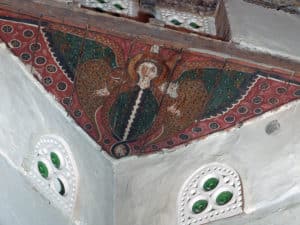 The Cherubim
The Cherubim
Above the series of small windows last described, a bonding timber runs through all four walls of the sanctuary to take the stress of the octagonal base of the dome. The four sides which cut off the angles of the square are carried on sleepers.
Three of these soffits show the bare timbers which support the octagon decorated only with a small painted decorative pattern. The fourth soffit, overhanging the northeast angle of the sanctuary (in front of the visitor, on the left), however, is cased with a ceiling of planks on which is painted a remarkable figure. The head is human and nimbed. The abundant hair is confined with a narrow fillet. The hands, too, are human and outspread, probably in adoration, though the elbows are kept close to the sides. The body is oval and, with the legs, is intended to be that of a bird. It terminates in an incongruous egg-shaped tail, and from the shoulders spring a pair of outspread wings which fill the two outer angles of the triangular field. The surface of each wing is conventionally represented as soft-feathered near the body, but at the edges is sown with large circular eyes in imitation of a peacock’s tail. From the left shoulder projects the head of a bull, from the right, that of a lion. Above the top of the nimbus protrudes the head of an eagle, and between the nimbus and the left wing a second human head is dimly visible. The figure is designed on the model of the “living creatures” seen by Ezekiel (Ezek. 1) and it embodies the Coptic conception of the “cherubim,” who was so intimately associated with Saint Macarius during his lifetime, and who actually appeared to Benjamin I during the original consecration of this very sanctuary. The painting was possibly intended to commemorate that event. Moreover, the figure of the cherubim in the sanctuary might also indicate that we are at the presence of the glory of God which dwells in the sanctuary (the four cherubs were transporting the divine chariot in Ezekiel’s vision). The date of this work is perhaps in the middle of the eleventh century.
The dome
The dome is pointed. Its profile is formed by two regular arcs. As usual in Egyptian domes, the courses are laid flat and form a series of concentric rings. The material used is dark red, burnt brick bedded in white lime mortar. According to Butler, the dome was once adorned with fresco paintings. The monks had a tradition at Evelyn-White’s time that there was formerly a lamp of precious stone which hung from the dome in this sanctuary. It is alleged to have been taken away by the Muslims, probably in the ninth century, and sent to Mecca.
The Sanctuary of the Three Young Men of Babylon
This sanctuary is dedicated to the three young men of Babylon. Sidrak, Misak and Abednego (Hebrew names Hananiah, Misael, and Azariah) are figures from the biblical Book of Daniel, primarily chapter 3. King Nebuchadnezzar II, King of Babylon, set up a golden image and commanded that all his officials bow down before it. All who failed to do so would be thrown into a blazing furnace. Certain officials informed the king that the three Jewish youths Hananiah, Misael, and Azariah, who bore the Babylonian names Sidrak, Misak and Abednego, and whom the king had appointed to high office in Babylon, were refusing to worship the golden statue. The three were brought before Nebuchadnezzar, where they informed the king that God would be with them. Nebuchadnezzar commanded that they be thrown into the fiery furnace, heated seven times hotter than normal, but when the king looked, he saw four figures walking unharmed in the flames, “the fourth… like a son of God” (Dan. 3:92). This fourth man has been interpreted by some Church Fathers as the prefiguration of Christ Himself who protects Christians from the fire of the world as He protected the three young men from the burning furnace.
St Irenaeus says:
[The] Word [of God], as he willed it and for the benefit of those who saw, shew the Father’s brightness and explained his will.… He appeared to those who saw him not in one figure or in one character but according to the reasons and purposes that he wanted to achieve, as we see written in Daniel. He was seen with those who were around Ananias, Azarias and Misael as present with them in the furnace of fire, in the burning, and preserving them from [the effects of] fire.[7]
St Jerome says:
As for the fourth man, which he asserts to be like the son of God… this angel of the Son of God foreshadows our Lord Jesus Christ, who descended into the furnace of hell, in which the souls of both sinners and of the righteous are imprisoned, in order that he might without suffering any scorching by fire or injury to his person deliver those who were held imprisoned by chains of death.[8]
Seeing this, Nebuchadnezzar brought the youths out of the flames and promoted them to high office, decreeing that anyone who spoke against God should be dismembered. The Greek Septuagint version of Daniel 3 includes the deuterocanonical Prayer of Azariah and Song of the Three Holy Men. The song has become an ode sung in the morning praises (Psalmody or Tasbiha) and on other occasions in the Coptic Church.
This sanctuary was discovered in 1970s during the rearrangement of the spaces around the Church of St Macarius. In this space, which was certainly a third sanctuary annexed to the main one. Ancient Coptic inscriptions have been found on its sides, dating back to the ninth century. It was also discovered from the way its wall was built—a red brick row, followed by a wooden extension, then a red brick row, and so on—that the original wall dates back to the seventh century, at the time of the consecration of the Great Church.
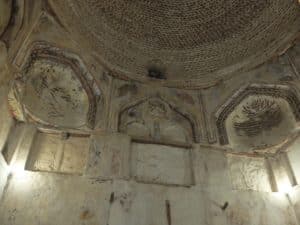 The Sanctuary of St John the Baptist
The Sanctuary of St John the Baptist
The eleventh-century altar of Saint Mark superseded a narrow lateral sanctuary corresponding to the south sanctuary. It contains two parts—the altar proper and a shallow western annex termed by Butler an “inner choir.” Both are considerably distorted by a conflict between the new axis, on which the altar as a whole is laid out, and the old alignment of the sanctuary of Benjamin which determines the direction of the southern wall.
At the time of Butler’s visit and in 1911 this space was further enclosed by screens drawn across the two archways. Butler’s description shows it to have been a rectangular framing containing a number of small oblong panels. There are two main varieties; examples of each are 43 centimeters high and 21 centimeters wide, but differ in thickness (4-7 and 2 centimeters respectively) and consequently in the depth as well as in the detail of the design. There are, besides, two or three half panels, 15 x 21 x 2 centimeters, which must have been used to fill smaller openings, such as the upper part of the door, where space did not admit of a panel of full height. As Butler observes, these panels are remarkable equally for the beauty of their design and for the depth (3 centimeters) of the cutting in the thicker examples. The ornamentation is of a well-known Fatimid era type. There are numerous examples at Cairo either in situ or in the Museum of Arab Art, the most important being the great doors from the Mosque of al-Azhar, which bear the name of the Caliph al-Hakim (AD 996-1020). It has been suggested that the “Nitrian” screens in Fatimid era style date from after the ravaging of the monasteries by the Lewata bedouins in 1069; but the exact dating of such panels within the general period is not yet possible. In the instance before us the panels belonged to a Fatimid building which was apparently erected in the first half of the eleventh century before the “deeds of violence” of the Lewatas, but the screen may well be later.
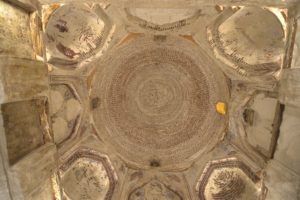 The interior plan of the altar is nearly a square on which the side walls rise to a height of just over 5.5 meters. Upon the cube so formed is set the octagonal basis for the beehive dome, which is modern. The dome of this sanctuary has often collapsed and been restored. When it collapsed in the 16th century, the sanctuary has been left weather-beaten for five centuries until 1912.
The interior plan of the altar is nearly a square on which the side walls rise to a height of just over 5.5 meters. Upon the cube so formed is set the octagonal basis for the beehive dome, which is modern. The dome of this sanctuary has often collapsed and been restored. When it collapsed in the 16th century, the sanctuary has been left weather-beaten for five centuries until 1912.
The reconstructed altar stands upon a slightly raised platform which extends over the whole floor of the sanctuary, save for a space 2 meters wide immediately within the entrance. It is of the regular type and is covered with a large marble slab of the combined square- and-circle form with false drain. As in the main sanctuary.
In the center of the east wall is a wide and deep niche, surmounted by a keel arch enriched, like the western arch, with a double row of painted chevron pattern. The “traces of an interlacing pattern within the recess” are now hidden by a coat of plaster. Two further niches in the east wall, one to the north and the other to the south of the center, are now filled in. Three niches in the north and two in the south wall have also been effaced. The two latter were carried through the thickness of the wall and were so placed as to communicate with two of the niches in the north wall of the haikal of Benjamin. Moreover, in the western half of the south wall there was a doorway communicating directly with the main sanctuary which, too, is built up; the “arched heading of carved stonework” seen by Butler has vanished.
By a surprising piece of good fortune this sanctuary has so far escaped lightly from the hands of the modern plasterer. Consequently the “remains of some frescoed figures now almost indistinguishable,” noted by Butler on the east wall, are still uneffaced, while the decoration of the upper parts of the sanctuary remains in a state of preservation which is relatively satisfactory.
The Frescoes
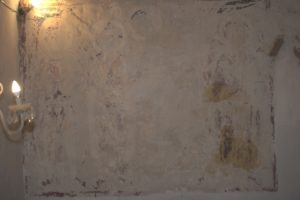 In the space at the north end of the east wall are seen the upper parts of four figures rather less than life size, so sorely scarred and battered that it is hopeless to describe them further than to say that two, and perhaps all four, are robed in richly diapered cloaks or mantles like copes, open in front and hanging straight from the shoulders. The identity of these figures is established by faint inscriptions painted in white on the red border above the scene. They are the Three Children of Babylon: the first is labelled Ananias, the fourth, Misael, the second is therefore Azarias and, the third the Christ in their midst, or maybe Michael, since some popular Coptic exegesis (like the Encomium of Michael by Theodosius) identifies the fourth personage seen in the furnace of fire (cf. Dan. 3:25) with Michael.
In the space at the north end of the east wall are seen the upper parts of four figures rather less than life size, so sorely scarred and battered that it is hopeless to describe them further than to say that two, and perhaps all four, are robed in richly diapered cloaks or mantles like copes, open in front and hanging straight from the shoulders. The identity of these figures is established by faint inscriptions painted in white on the red border above the scene. They are the Three Children of Babylon: the first is labelled Ananias, the fourth, Misael, the second is therefore Azarias and, the third the Christ in their midst, or maybe Michael, since some popular Coptic exegesis (like the Encomium of Michael by Theodosius) identifies the fourth personage seen in the furnace of fire (cf. Dan. 3:25) with Michael.
In the corresponding position at the south end of the wall we might expect Daniel in the lions’ den; but the painting has almost entirely perished. In the upper left portion alone is anything intelligible preserved. Here the surface coloring has peeled off, but the artist’s preliminary sketch in red ocher outline is visible, showing the heads of six persons arranged in two close rows, probably to represent a crowd witnessing the main scene.
On the adjoining east end of the north wall there is a well-preserved fragment which probably belongs to the destroyed painting. This represents a small pavilion whose main features are a doorway flanked by a pair of columns to which two curtains are looped back, and a dome having seven small windows in its drum. Such a building may well have formed part of the general mise en scene of the lost painting, perhaps indicating Babylon, or the royal palace.
Fortunately, the artist’s signature is preserved, painted vertically in black lettering beside the left edge of the scene, and reading as follows:
[…ⲙⲓⲙⲟⲛ]ⲁ[ⲭⲟⲥ] ⲓⲱⲁⲛⲛⲏⲥ ⲡⲓⲍⲟⲅⲣⲁϥ[ⲟ]ⲥ ⲡ[ϣ]ⲏⲣ[ⲓ ⲛ]ⲁⲃⲃⲁ ⲡⲓϣⲟⲓ
The monk, John the Limner, the son of Abba Pishoi
Presumably the remaining decorations of the sanctuary are by the same local artist.
Above the shoulders of the central eastern niche are remains of figures at a smaller scale too imperfect to be recognized or described. The scenes on the north and south walls have entirely disappeared.
At 4.2 meters above the original floor level are the sills of a series of rectangular openings, which measure 1 x 1.6 meters. There are three each in the north, east, and south walls. While the western wall, owing to the height of the sanctuary arch, there are two only. All are now blocked. The three openings in the east wall were obviously windows, each divided by a vertical wooden mullion into two equal parts, and originally filled with stucco tracery set with panes of colored glass. In the northernmost window on the east side the wooden mullion is still partly visible, but the tracery has altogether disappeared. On the north side, however, there are only shallow recesses having plastered backs painted with fine arabesque patterns. The blinding of these windows is by design to exclude the prevailing, sand-laden north wind. On the south the central opening was probably carried right through the wall, meeting one of the windows in the north wall of the main sanctuary. The other two must have been blind, since they coincide with no opposite opening.
The spaces between these windows were painted with a series of figures of famous monastic heroes grouped in pairs. Thus, in the easternmost space on the north wall are two figures. To the right is a personage in the attitude of prayer, long bearded, and attired in a square-plaited tunic of palm leaves, to whom a bird is bringing food. These attributes, with the label [ⲡ]ⲁⲩ[ⲗ]ⲟⲥ painted on the red border above, show that this is Paul the Great or the Hermit. Accompanying him is an unidentified person, doubtless Saint Antony (though the initial letter of the inscription is ⲡ). He is represented nimbed and wearing a full, square white beard, his head covered with a slightly pointed monastic cowl, his hands appearing to be crossed upon his breast. The lower part of the figure is almost completely erased.
In the next space toward the west are two standing figures, each with a nimbus. The one has a white beard and wears a dark red tunic and a white mantle, the other wears a white tunic and a red mantle. Of these figures only the heads and shoulders are preserved. Between them is a rectangular tablet painted yellow with the following inscription in black:
ⲡⲁⲓ ⲛⲉ ⲛ︦ⲕⲁⲛⲱⲛⲛⲉⲙⲛⲓⲉⲛⲧⲟⲗⲏⲛⲧⲉ ϯⲙⲉⲧⲙⲟⲛⲁⲭⲟⲥ | These arethe canonsand thepreceptsof monasti-cism |
On the red upper border is the unfinished description ⲁⲃⲃⲁ. One of the two is doubtless Pachomius, whose code of monastic rules is well known; the other may be Macarius.
At the north end of the west wall is another pair of figures, of whom one, nude save for a beard reaching to his knees, is certainly Onophrius (Abu Nufar); but these are quite fragmentary. In the adjoining northern spandrel of the western arch is a single large figure, robed in red and white, bowed toward the center of the arch. In both hands he holds an ornate volume. There is a corresponding, but less perfect, figure in the southern spandrel; both seem to be allegorical, and may represent the Old and New Testaments. In the northern of the two corresponding spaces on the east wall a bearded figure wearing a short cape-like garment is dimly visible, and to the right of this figure is the oval bird body of a seraph. A similar pair with the seraph still to the right of the human figure fills the corresponding space in the south half of this wall. One of these represents Macarius the Great with his guardian “cherubim.”
Immediately above this range of windows and the intermediate decoration, a bonding course of timber runs all around the sanctuary. It was originally faced with stucco which, immediately under the squinches, was colored black and inscribed with a dedicatory inscription in white Coptic lettering. So much of the text as is legible runs as follows:
(On the east end of north wall)
ⲁϥϣⲱⲡⲓ ⲛϫⲉ ⲡⲁⲓ ϣⲉⲛⲉⲣⲫⲙ[ⲉⲩ]ⲓ ⲉⲑⲛⲁⲛⲉϥ ⲉ[…]
Was made this good memorial
(Located on the north end of east wall)
[…ⲡⲁⲓ] ⲑⲩⲥⲓⲁⲥⲑⲏⲣⲓⲟⲛ ⲉⲑⲟⲩⲁⲃ … […]ⲛ[…]
this holy altar [by]
(The south end of east wall is illegible)
(The east end of the south wall)
…ⲉⲧⲁⲩϣⲉⲡϧⲓⲥⲓ ⲛⲉⲙⲁϥ ϧⲉ[ⲛ ⲡ]ϫ[ⲓⲛ…]ⲙϥⲓ ⲫⲱⲟϣⲉⲡⲁⲓⲱⲧ those who toiled with him in the [building?]…
(The west end of the south wall)
[…]… ⲡⲉϥⲛⲓϣϯ ⲛⲛⲁⲓ ⲛⲉ[…] [May God of] His great mercy
(The remainder is totally illegible).
The imperfection of this inscription is the more regrettable since it certainly named the builder and most probably contained the date of construction.


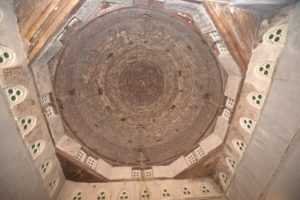
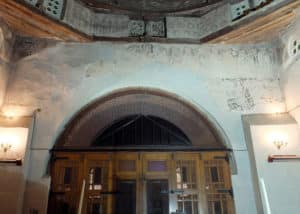
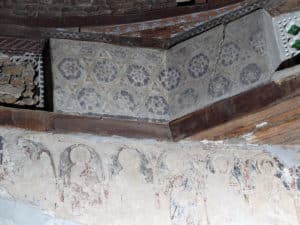
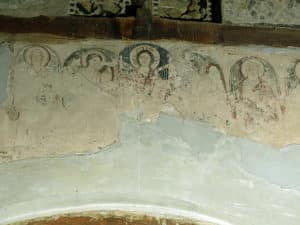
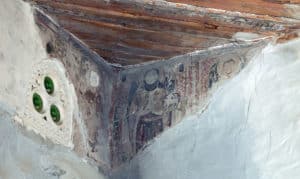
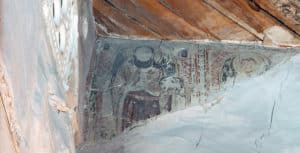
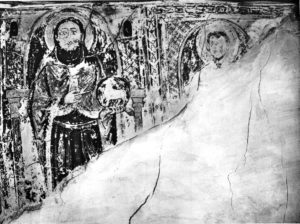
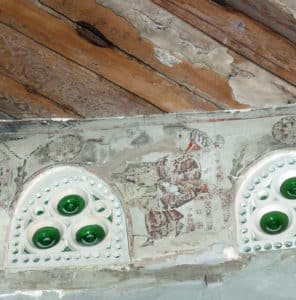
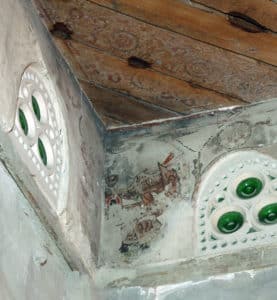
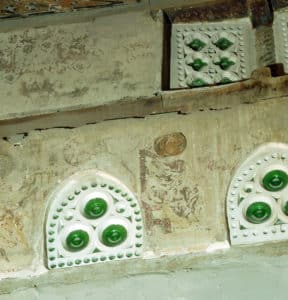
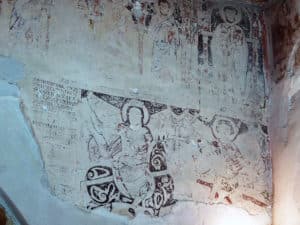
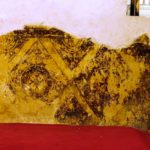
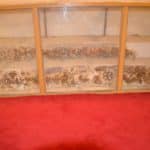
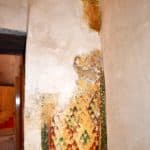
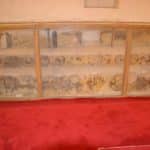
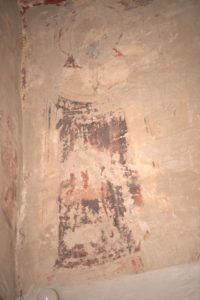
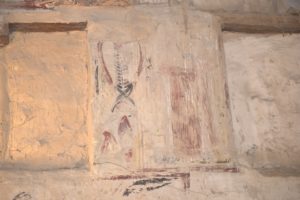
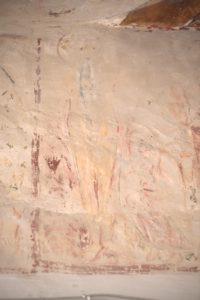
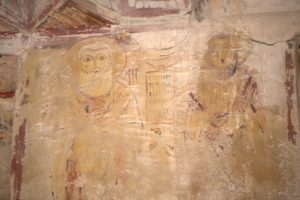
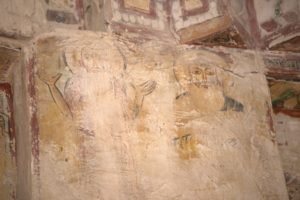
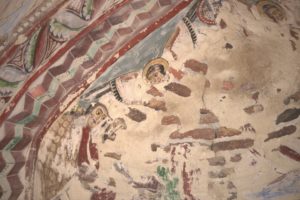 The octagon is richly decorated with paintings. The small detached fields left between the minor windows on the four main sides invited a series of balanced medallions and small panels; the surfaces of the coved recesses were suitable for scenes of some extent; and the spandrels above the eight arches were excellently adapted to simpler scenes in which, normally, two figures are confronted.
The octagon is richly decorated with paintings. The small detached fields left between the minor windows on the four main sides invited a series of balanced medallions and small panels; the surfaces of the coved recesses were suitable for scenes of some extent; and the spandrels above the eight arches were excellently adapted to simpler scenes in which, normally, two figures are confronted.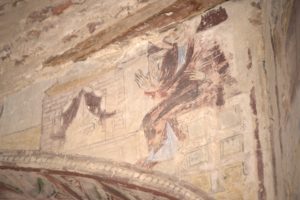
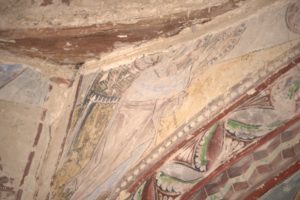
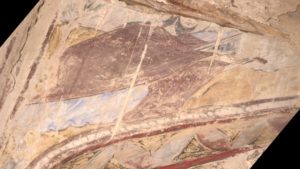
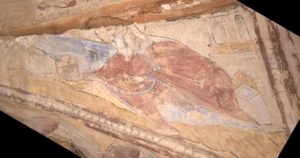
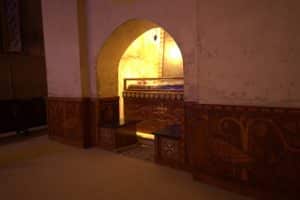 Ten Patriarchs Buried in the Church
Ten Patriarchs Buried in the Church